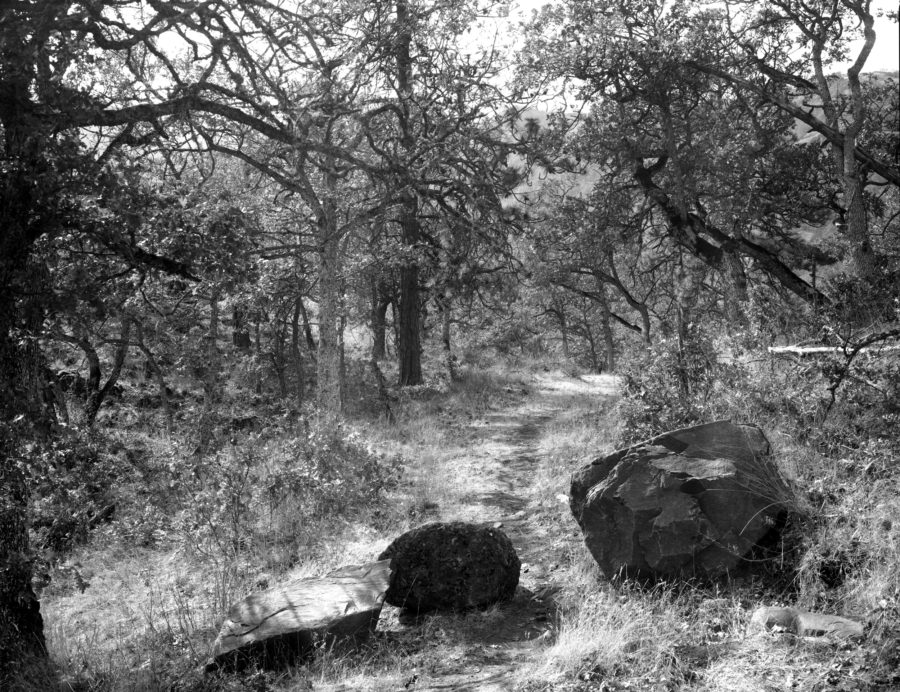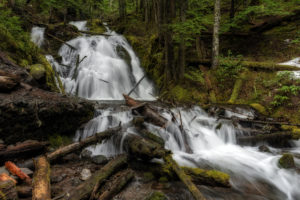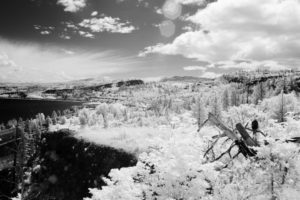Part of my recent adventures in the darkroom has been to try to settle on a film / developer combination to stick with so that I can make my film work more consistent. The first steps in this has been a bit rocky, but I am slowly moving through a backlog of both films and developers. Some prerequisites are as follows:
Films must be available in most or all formats that I use: 8×10, 5×7, 4×5, and 120. Developers must not be too fussy, or burn holes in the sink.
Here are a few of films.
Films:
Ilford HP5+
Ilford FP4+
Ilford Ortho+
Kodak Tri-X 320
Kodak T-Max 100
Kodak T-Hax 400
Adox CHS 100
Fomapan 100
Arista 100
Bergger Panchro 400
Developers:
Agfa Rodinal
510-Pyro
Hypercat
Ilfotec-HC
Kodak Xtol
Kodak D76
PF FA-1027
Clayton F76+ (could be the same as FA-1027)
Kodak HC-110
Caffenol
Divided D76
Harvey’s Panthermic 777
Edwal 12
Wimbley’s W2D2
PMK Pyro
Pyrocat HD
Divided D23
Kodak Microdol-X
Ilford Perceptol
PF Exactol Lux
I wrote some of the developers off already, as I tested them some years ago. I mention them only to illustrate how far and wide my exploration have ventured. Here are some of the results from recent testing.
Ilford Ortho+

©2022 Gary L. Quay
There was some storming going on in the Columbia Gorge a few weeks ago. I have been developing Ortho+ in 510-Pryo for a while, but I decided to try Ilfotec-HC this time. My main complaint is that the grain is noticeably larger, so I will go back to the Pyro developer.
Ortho+ will remain a special-purpose film regardless. Its high contrast means that some situations that require it. I like it best for forest scenes on gray days, and for waterfalls. Its slow speed lends itself to blurred motion.
Camera: Hasselblad 500CM
Lens: 250mm Zeiss Sonnar
Film: Ilford Ortho+ exposed at 40 ASA, and developed in Ilfotec-HC

©2022 Gary L. Quay
I didn’t quite manage to keep the rain and the spray from the falls off of my lens, but this one didn’t have too many splatters on the lens.
Ilford developers are designed to work better with Ilford films. The grain is not as noticeable with this one, but it’s possibly due to the darkness of the image.
Camera: Hasselblad 500CM
Lens: 50mm Zeiss Distagon
Film: Ilford Ortho+ exposed at 40ASA, and developed in Ilfotec-HC

©2022 Gary L. Quay
This is the first roll of film that I put through my new Hasselblad Flexbody. I was able to get the entire scene in focus at f16. It definitely is a different kind of camera. I’m hoping that it will take my photography to another level. We’ll see.
I used my usual soup with this roll of Ortho+. The grain is noticeably smaller, and the tones are a little better. It was a dark day, just like the previous 2 images, so some of the darkness is natural, and not the fault of the developer. I continue to think that 510-Pyro, or even PMK Pyro works best with Ilford Ortho+.
Camera: Hasselbad Flexbody
Lens: 50mm Zeiss Distagon
Film: Ilford Ortho+ developed in 510-Pyro.
Ilford HP5+

©2021 Gary L. Quay
FA-1027 and Ilford HP5+ seem to be a match made in heaven. Rumors have it that it’s the same thing as Clayton F76+, but I’ve seen different development times for the same films. I have used both of them. It’s not a cheap developer to use, but it’s not too bad. It’s one of the combinations that I am strongly considering stickling with.
Camera: Deardorff V8
Lens: 165mm Schneider Angulon
Film: Ilford HP5+ developed in Photographers Formulary FA-1027

©2010 Gary L. Quay
This is the Southpark Fish House in Portland, Oregon.
I present this one for historical purposes. I wanted to try Harvey’s Panthermic 777 developer. It’s “Panthermic” because it delivers the same image quality over a larger temperature range than normal. And, its ability to keep detail in highlights is legendary. I probably will not return to this developer unless I do many more night images, but it was fun to experiment with.
The exposure was 80 seconds at F16. The meter indicated 12 seconds with HP5 rated at 200 ASA instead of 400. Reciprocity failure compensation took it to 40 seconds, and I added 1 stop to correct for N-1 contraction in development to help control the highlights. In the darkroom, the time suggested for Harvey’s Panthermic 777 developer was 11 minutes @ 74ºF. My darkroom was at 65º, which took it to 18:45. I subtracted 30% for the 200 ASA rating, 30% of the remaining time for N-1 contraction, and 20% for compensation for reciprocity. I ended up with 8 minutes total development time.
Most astoundingly, you can seen the scales in the fish sign without burning them in.
Camera: Deardorff 8×10.
Lens: 19″ Goerz APO Artar.
Film: Ilford HP5+ developed in Harvey’s 777.

©2008 Gary L. Quay
It was late November in Portland. By some miracle it was not raining. A member of a local band called “Tapwater” stopped by to talk about my camera, which looks very out of place these days. This was an 11 minute exposure, so you can’t see said member of Tapwater running along the street before coming over to talk. My wife and I had seen the band a few years back at the Oregon State Fair, and had bought their CD. Considering just how out of the loop we are with today’s music, it seemed highly coincidental to run into a member of a band I had actually heard of.
HC-110 is a highly versatile developer. Using different dilutions, one can achieve many different contrast effects. Generally, the weaker the dilution, the lower the contrast. It will not get you fine grain like FA-1027, but it won’t give you fat grain like Rodinal. I had written it off due to the recent change from a thick syrup to a thick, water-based concentrate. My concern was that it would no longer have its fabled long shelf life, but thinking about it further, if it would be my only developer, that would not be an issue.
Camera: Calumet C-1 with 8×10 back
Lens: Hyatt’s Rapid (Made about 1880)
Film: Ilford HP5 developed in HC-110
Bergger Panchro 400

©2022 Gary L. Quay
I have been testing long development times. I developed this one 1:50 in Rodinal for 25 minutes. I realized half way through that my darkroom was not entirely light tight, so the negative is a little fogged. I need to do a little more work on it before I develop more sheet film.
Rodinal is another versatile developer. It can create very high contrast with more concentrated dilutions, and can act as a compensating developer in lower concentrated dilutions. Compensation means bringing out the shadow areas while retarding the highlights. It’s useful in night photography and high contrast scenes.
It enlarges the grain, while providing fairly good sharpness, making for punchier negatives.
Bergger Panchro 400 is a fairly trouble free film. It’s one of the newer 8×10 films on the market, and seems to be fairly reliable. Is it as reliable as HP5+? I don’t know. It certainly is cheaper.
Camera: Deardorff V8
Lens: 360mm Schneider
Film: Bergger Panchro 400 developed in Rodinal
Ilford FP4+

©2021 Gary L. Quay
I got my Deardorff back from being repaired in June, and wanted to get out to take some pictures with it. Unfortunately, the day I picked was gray, and slightly smoky (as it is wont to be in the American West these days), but I didn’t want it to be a total bust, so I stopped in the shadow of Rowena Crest, and pointed my camera to the other side of the road where some white oak trees were growing along the rim of a small valley. I was testing for light leaks. I do not appear to have any. This is good. The camera seems to be repaired thanks to Blue Moon Camera and Machine in Saint Johns, Oregon.
For this picture, I wanted what Ansel Adams called “A soft, enveloping light.” I’m not sure that I acheived it, but it certainly is soft.
FP4+ is slightly higher contrast than HP4+, but it is a slower film, which means that you need the scenery to sit still for longer exposures.
I developed this in Ilford Perceptol. It’s a fine grain developer that works a little soft, meaning lower contrast. It also costs a stop of film speed, rendering this film about 60 ASA. Its normal speed is 125 ASA. I increased development time for this picture to bring out a little more contrast.
Camera: Deardorff 8×10
Lens: 19″ Goerz APO-Artar
Film: Ilford FP4+ developed at N+1 in Ilford Perceptol.
I will discuss other films and developers in a future post as I narrow down the field.
Thanks for reading!
Gary L. Quay



